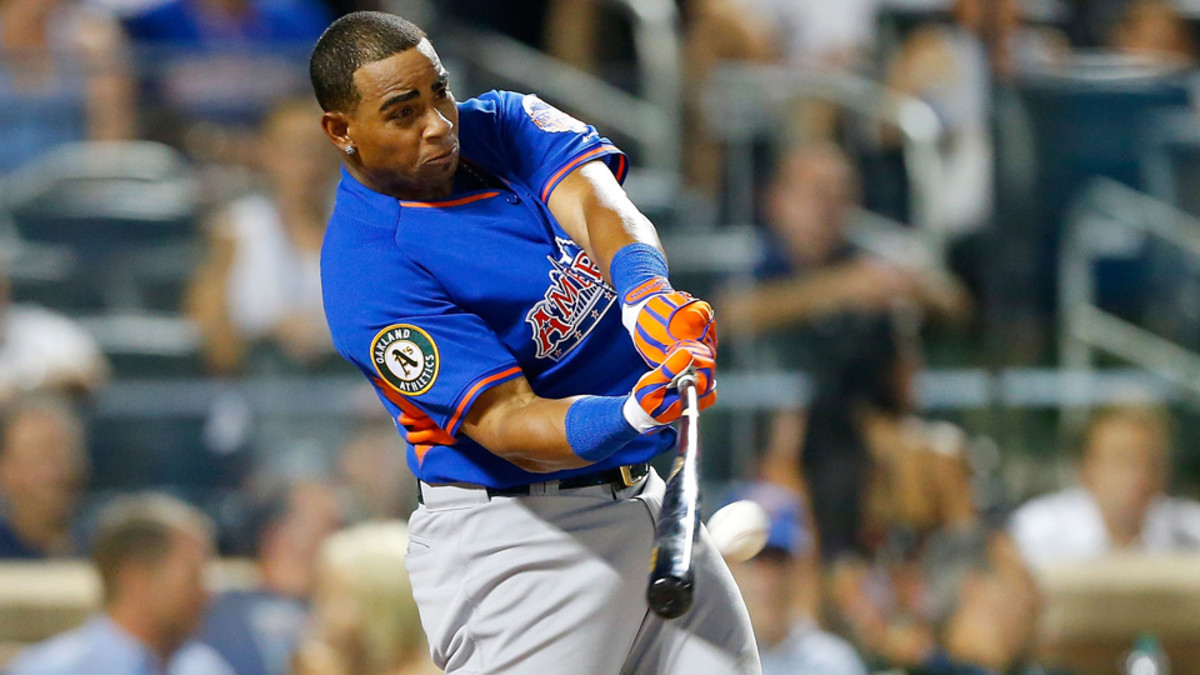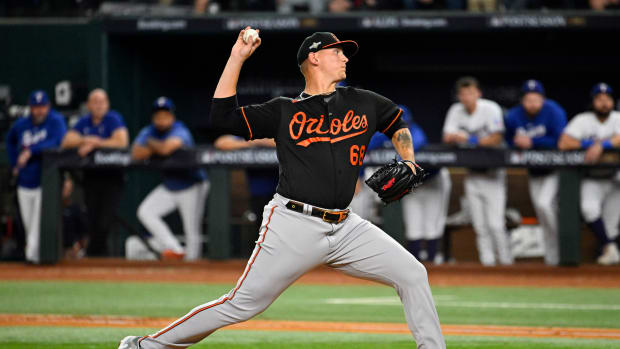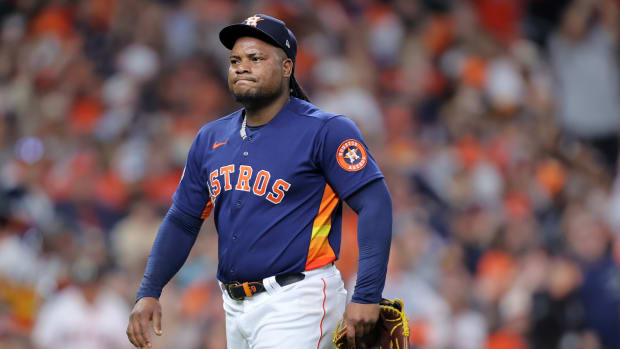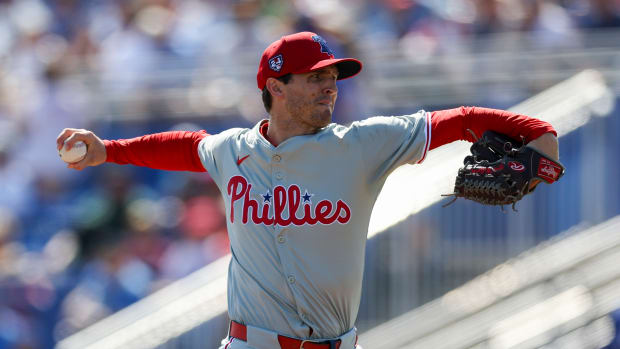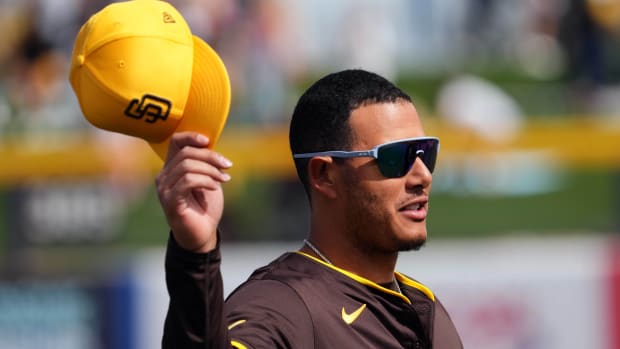Home Run Derby preview: Can anyone dethrone Cespedes as champion?
The 30th annual Home Run Derby takes place Monday night at 8 ET at Minneapolis’ Target Field. That's a notoriously difficult park in which to hit home runs, but one that was nonetheless the site of some prodigious batting practice shots by the minor leaguers taking part in the Futures Game on Sunday, a game which was itself defined by a pair of impressive roundtrippers. This year’s derby features a new format for the first time in a decade and an expanded field of contestants. Of the 10 participants, seven are first-timers. The exceptions are defending champion Yoenis Cespedes, American League captain Jose Bautista and former Twin and 2008 winner Justin Morneau.
The Format: The last 10 Home Run Derbies followed the same format: Eight hitters each got 10 outs per round spread out over three rounds, with the bottom half of the field being eliminated in each round. This year, however, the derby has a new format: 10 hitters, four rounds and seven outs per round. It also uses a bracket format to generate head-to-head matchups and keeps the American and National League contestants on opposite sides of the bracket to produce a guaranteed AL versus NL final. The result is that the derby will have the same maximum number of outs (140), but far more action.
Round 1 will seed the hitters in each league, with the bottom two being eliminated and the top seed getting a bye for Round 2. The second and third seed will then face off in Round 2, with the winner taking on the top seed in Round 3. That will produce a champion for each league, with those two men facing off in the finals to determine the winner.
The Ballpark: Target Field
Target Field, the newest ballpark in the American League and second-newest in the majors behind Marlins Park, opened in 2010, and it immediately developed a reputation as a home-run suppressing ballpark. Twins star Joe Mauer famously hit just one home run at home in the ballpark’s first two seasons, while Morneau hit only four of his 22 home runs there over the same span.
Target Field is an especially challenging home-run park for lefties like Mauer and Morneau. According to the park factors in the 2014 Bill James Handbook, from 2011-13, the only three parks in which it was harder for a lefty to hit a home run were Oakland, San Francisco and Miami. Target Field’s wall is closer in rightfield than in left, but it is also nearly three times as high. To hit a home run anywhere from the right of the batter’s eye to the rightfield foul pole, a hitter has to clear a 23-foot wall which is 328 feet away down the line, 365 feet away in the gap and 403 feet away at its deepest point in right-center. There is a small section of seats that sticks out over the warning track in the rightfield gap, but it is minimally beneficial to lefty pull hitters.
Target Field is far more conventional for righties. Leftfield is deep (339 down the line, 377 in the gap, 411 in center), but the wall is a standard eight feet, so while it’s still more difficult to hit home runs to left in Target Field than in a neutral park, it is not a challenge on par with right. Given all of that, it’s interesting to note that the only lefthanded hitter taking part in Monday night’s derby is Morneau, who was selected by his Rockies teammate and NL captain, Troy Tulowitzki.
The Sluggers:
Note: The 10 derby participants are listed here in order of their 2014 home runs and home runs on contact percentage (the figure in parentheses after their home run total). "Long" is the distance in feet of each hitter's longest home run this season (with a video link).
American League
Josh Donaldson, 3B, Athletics (R)
2014 HR: 20 (6.9%)
Career HR: 54 (5.4%)
Long: 448
Donaldson hit 17 of his 20 home runs this season by June 6 but then fell into a deep slump, going 0-for-32 without so much as a walk over that span. In 134 plate appearances since the start of that slump, Donaldson has hit .159/.201/.254 with just three more home runs and a total of five extra-base hits. I wrote in mid-June that Donaldson’s struggles were in part the result of his generating an excess of groundballs. He has thus far corrected that trend in July, dropping his groundball rate below his career average, but improved results have not followed.
Jose Bautista, RF, Blue Jays (R)
2014 HR: 17 (6.4%)
Career HR: 228 (7.3%)
Long: 450
A pure righthanded pull hitter, Bautista loves hitting at Target Field. He has 11 home runs and a .966 slugging percentage in 66 career plate appearances there and has gone deep a whopping 22 percent of the time that he makes contact. However, he has been limited by a hamstring strain of late, missing six games at the end of June and starting his first 11 games of July at designated hitter or first base. Also, he has not homered since July 2, going 46 plate appearances since his last roundtripper and hitting just two home runs in his last 116 PA. Nonetheless, Bautista remains one of the game’s premier power hitters, having hit 169 home runs over the last 4 1/2 seasons. Bautista previously participated in the 2011 and '12 derbies, losing to Prince Fielder in the finals at Kansas City's Kauffman Stadium in the latter year.
Brian Dozier, 2B, Twins (R)
2014 HR: 18 (6.3%)
Career HR: 42 (4.2%)
Long: 418
Dozier is not among this year’s crop of 81 All-Stars, but while his inclusion in the derby is obviously a gesture to the hometown fans, his rank on this list proves that he’s deserving of the spot. His two home runs against the Rockies on Sunday, the first multi-homer game of his career, gave him 18 for the season, more than any other AL participant other than the slumping Donaldson. Then again, those 18 taters rank just 12th in the league and tie Dozier’s career high, which was set in 623 plate appearances last year. In his first four professional seasons, spanning 1,953 plate appearances from rookie ball to the majors, he hit just 22 longballs. Both in his career and in 2014, Dozier has hit exactly half of his home runs at home in Target Field, but in both cases has done so in fewer plate appearances than he has had on the road.
Adam Jones, CF, Orioles (R)
2014 HR: 16 (5.0%)
Career HR: 156 (5.0%)
Long: 439
Jones is the most inexplicable choice among this year’s 10 derby participants, which means he’ll probably win the thing. Jones is an established home run hitter, having hit more than 30 in each of the last two seasons, but his 16 homers are 15th in the American League, and he’s never really been among the game’s power elite.
To be fair, the list of the nine AL hitters with at least 20 home runs include players who are either injured (Edwin Encarnacion and Victor Martinez), declined Bautista’s invitation (Nelson Cruz and Mike Trout) or strongly implied that they would decline (Jose Abreu). Factor in a pair of lefthanded hitters (Brandon Moss and David Ortiz) and it’s easier to see how Bautista wound up with Jones. Jones hasn’t homered in his last 45 plate appearances, but he hit 10 in 29 games prior to his current drought.
Yoenis Cespedes, LF, Athletics (R)
2014 HR: 14 (4.9%)
Career HR: 63 (5.9%)
Long: 427
Last year, Cespedes was the player whose participation in the derby was hardest to figure out. Of course, all he did was hit 17 home runs in the first round and 32 overall, tied for third-most ever in a derby. If he had used all 10 outs in the final, Cespedes likely would have surpassed Josh Hamilton’s 35 homers from 2008 for second-most in a single derby behind Bobby Abreu’s 41 from 2005, something he admitted in his press conference afterward that he would have tried to do had he realized where he was on the all-time leader list.
This season, Cespedes has impressed far more with his arm (including what might be the throw of the year) than his bat, and he arrives in Minneapolis having gone homerless in his last 91 plate appearances, the longest pre-derby drought of any of this year’s participants.
National League
Giancarlo Stanton, RF, Marlins (R)
2014 HR: 21 (8.4%)
Career HR: 138 (9.6%)
Long: 484
No derby performance is more hotly anticipated than that of Stanton. He is tied with Tulowitzki for the league lead in home runs and leads all major leaguers (minimum 10 home runs) in average longball distance this season. Stanton’s 21 homers have had an average true distance of 423.8 feet according to ESPN’s Home Run Tracker, and his 484-foot shot back on April 4 remains the second-longest in the majors this year behind only Mike Trout’s recent 489-footer in Kansas City. Furthermore, Stanton’s 494-foot blast in Colorado in 2012 is the longest home run of the last five years.
Stanton is arguably the best young power hitter in baseball: His 138 career home runs lead all active players under age 25 by a mile (Trout is second with 84), and among the 10 men in this year’s Derby, the 24-year-old Stanton is the second youngest (Puig is 23) but is fifth in career home runs. All of that said, Stanton is not impervious to home run droughts and comes into the derby having not homered in his last 73 plate appearances.
Troy Tulowitzki, SS, Rockies (R)
2014 HR: 21 (8.1%)
Career HR: 176 (5.9%)
Long: 447
Tulowitzki leads the NL in slugging at .613 and snapped a lengthy home run drought of his own (84 PA) with three in two games late last week. As that drought would suggest, Tulo has cooled off from his Ruthian start to the season but is still hitting .336/.408/.537 with seven home runs since the beginning of June. Of course, when discussing a member of the Rockies, one must call attention to home-road splits, and Tulowitzki’s have been significant this season. His home run percentage is 10.1 in Coors Field this season and 5.8 everywhere else. You’ll note, however, that the latter figure is an almost exact match for his career rate and is superior to the 2014 rates of four other participants.
Todd Frazier, 3B, Reds (R)
2014 HR: 19 (6.7%)
Career HR: 63 (5.7%)
Long: 446
Frazier has hit 19 home runs in each of the last three seasons. In 2012, he did it in 465 plate appearances and finished third in the NL Rookie of the Year voting. Last year, it took him 600 PA to get to 19 homers. This year, he has done it in just 400 PA and has 67 games left to play in order to set a new career high in longballs. Frazier was one of just two derby participants to go deep on Sunday. In fact, he has homered in each of his last two games, breaking a -- you guessed it -- long home run drought of 84 plate appearances prior to those two shots. Frazier is the only participant in this year’s derby never to have played in Target Field.
Yasiel Puig, RF, Dodgers (R)
2014 HR: 12 (4.5%)
Career HR: 31 (5.6%)
Long: 452
After Cespedes won last year’s derby, he was asked how his young countryman Puig, who had made his major league debut a little more than a month earlier, would fare in the competition. Cespedes wasn’t that enthusiastic, saying that Puig, despite his eight home runs to that point, wasn’t really a home run hitter. To a certain degree, Cespedes has been proven right. As productive as Puig has been this season, he’s in a five-way tie for 28th in the National League in home runs, and only Morneau has a lower rate of home runs on contact this season among this year’s derby participants.
That said, when Puig does hit 'em, they fly. His average true home run distance this season (417.3 feet) is the fourth-longest in the majors among hitters with at least 10 home runs, trailing only Stanton, the Giants’ Michael Morse and Trout. One can argue that Puig doesn’t deserve to be in this year’s derby based on his home run frequency, but there are few players who are more fun to watch, and few whose home runs are more majestic than those of the Dodgers' headline-grabbing star.
Justin Morneau, 1B, Rockies (L)
2014 HR: 13 (4.3%)
Career HR: 234 (5.4%)
Long: 428
Despite his strong comeback season, Morneau is not an All-Star this year. He lost the final vote to the Cubs' Anthony Rizzo, as he should have, and one could argue that the results of that election suggested the fans would rather see Rizzo in this spot as well (Rizzo is second in the NL with 20 home runs, and his 7.4 home runs per contact percentage would rank third among all derby participants; Morneau, meanwhile, is tied for 24th in the former category and dead last in the latter). Morneau was chosen because he’s teammates with the NL captain and also because of the appeal of the storyline that finds the longtime Twins star having finally returned to something resembling his pre-concussion form, making a triumphant return to Minneapolis in Target Field’s first All-Star event.
Of course, that narrative ignores the fact that this ballpark was never a particularly welcoming place for the lefthanded Morneau. His home runs per contact rate in Target Field in his career is a mere 3.2 percent compared to 5.0 everywhere else in the five years since that park opened. And while Morneau has hit a strong .303/.337/.487 on the road this year, his home runs per contact rate outside of Coors Field has been a mere 3.8 percent. Those are lousy numbers in the context of this year’s derby field. What’s more, Morneau already has a derby win under his belt. A participant in 2007 and '08, it was actually Morneau, not Josh Hamilton, who won the derby at Yankee Stadium in 2008. Hamilton hit 20 more home runs than Morneau in the first round, but they both advanced and Morneau beat the winded Hambone, 5-3, in the finals. That was six years ago.
It would be a great story if the 33-year-old Morneau, the second-oldest man in this year’s derby after fellow 33-year-old Bautista, somehow found the fountain of youth, overcame that 23-foot wall and won this thing. The odds of that happening, however, seem absurdly slim.






























